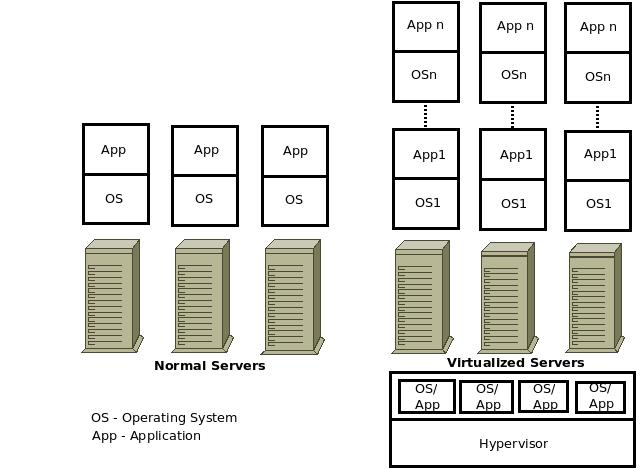What is Server Virtualization?
Servers rarely run at full capacity. Server Virtualization enables multiple applications running on multiple operating systems to run on the same server, utilizing that unused additional capacity. Lets find out more about Server Virtualization, in this article.
What is Server Virtualization?
 In the above diagram, the three servers on the left hand side represent stand-alone servers – There is an Operating System & an Application on each of them. That’s the conventional set up. Well, almost. There are some drawbacks with this set up – Some operating systems/ applications do not use all the resources of an entire server. So, the additional capacity goes under-used. Also, unless more physical servers are introduced, there is no back up for these stand-alone servers/applications – should they fail.
In the above diagram, the three servers on the left hand side represent stand-alone servers – There is an Operating System & an Application on each of them. That’s the conventional set up. Well, almost. There are some drawbacks with this set up – Some operating systems/ applications do not use all the resources of an entire server. So, the additional capacity goes under-used. Also, unless more physical servers are introduced, there is no back up for these stand-alone servers/applications – should they fail.
The three servers on the right hand side represent virtualized servers. In each server (for the sake of simplicity) lets consider that multiple applications are running on multiple operating systems. Each OS/Application is isolated from the others. Further, server resources like processor capacity/ RAM/ Hard-disk capacity etc, are reserved (or allocated) separately for each OS/Application.
The OS/Application pairs run over a software module called Hypervisor. The Hypervisor resides between the bare metal hardware and the virtual systems. It basically de-couples the Operating System/ Applications from the underlying physical hardware and provides a common management / operating platform for multiple operating systems/ applications.
So, in a nutshell, Server Virtualization can be defined as – Multiple instances of different operating systems/ applications running on a physical server hardware. This approach, has a lot of advantages as discussed below.
Advantages of Server Virtualization:
- Since the resources (RAM, Processor, etc) of the virtualized servers are utilized more (than stand-alone OS/App) as multiple operating systems and applications share the same server resources, Server Virtualization improves the resource utilization ratio.
- Server Virtualization enables server consolidation – resulting in the usage of less number of servers for the same OS/application(s).
- If a server is down (due to either hardware or application failure) (or) due to maintenance activities, application downtime can be avoided by migrating the virtual systems (OS/application pairs) to other servers. This ensures high availability of the applications.
- The applications can also be transferred from a primary data center to a secondary data center (by certain virtualization softwares, if up-to date copies are kept at the secondary data center) enabling effective disaster recovery strategy.
- Server Virtualization avoids over-purchasing/ over-allocation of servers for certain applications.
- On-demand resource allocation is possible along with the ability to scale up / scale down resources.
- The time required for getting an application up and running is greatly reduced, especially for smaller applications that can be provisioned in one of the existing virtual servers.
- Server Virtualization is an Operating System neutral technology – multiple operating systems can reside alongside in the same server.
- Even though various operating systems/ applications reside in the same server, they are logically isolated from each other thereby enhancing security.
- The operating systems/ applications (virtual systems) are hardware independent. They just need to communicate with the hypervisor and the hypervisor communicates with the hardware components.
- Server Virtualization is useful for testing applications / using them in the production environment temporarily as there is no need to buy additional servers for doing that.
Limitations of Server Virtualization:
- The resource allocation for each virtual system needs to be planned carefully. If very less resources are allocated, the application performance might be affected and if too much resources are allocated, it will result in under-utilization. The servers that are to be virtualized should have sufficient resources, in the first place.
- 32-bit processors/ operating systems/ applications can make use of only limited memory resources in the server (4 GB) and hence 64-bit computing is preferred for server virtualization. But not all the applications have been migrated to 64-bit computing yet.
- Only a few processors (that support virtualization) can be used to virtualize servers. And for migrating the virtual systems from one server to another, some vendors require similar model/make of processors.
- The hypervisor itself utilizes some processing power. This is in addition to the processing power required for the applications.
- The cost of virtualization software, management applications, management expertise required etc, might limit the usage of server virtualization in smaller environments with very few servers.
- Sometimes, a separate SAN/NAS network might be required for storage as there may not be sufficient storage capacity inside the server for multiple OS/ Applications.
- The software switch running inside the hypervisor to connect the various virtual systems (Operating System/ Application) may not be able to integrate with the existing network settings like VLAN/ QoS settings, etc. At least, they cannot implement all the features of a specialized network switches connecting to individual servers in a full fledged way.
excITingIP.com
You could stay up to date on the various computer networking technologies by subscribing to this blog with your email address in the sidebar box that says, ‘Get email updates when new articles are published’.
Good article on virtualization, Rajesh!
Thanks.